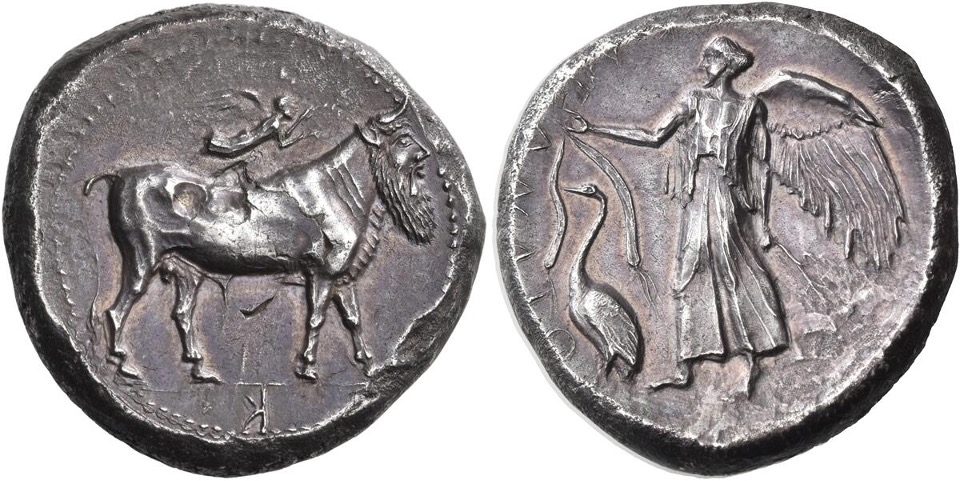445 BCE - 435 BCE | KATANAIOΣ
Overstriking coin
Catana Siracusa XVI, 6.jpg
Overstruck variety
2566 - Catana (tetradrachm).jpg
[1]
| Museum collectionMuseum collection:
|
Siracusa, Museo Archeologico, Gagfliardi coll., inv. 68921
|
|
|
|
|
Description
| ObverseInscription or printing placed on the obverse.:
|
Charioteer driving quadriga to right, holding kentron and reins. Above, Nike flying to right, crowning horses with wreath.
|
ReverseInscription or printing placed on the reverse.:
|
KATANAIOΣ (Greek) Head of Apollo right, wearing laurel wreath.
|
Mint and issuing power
| MintIdentifies the place of manufacture or issue of a numismatic object.:
|
Catana
|
Ancient regionAncient region.
|
Sicily
|
Modern countryModern country: Italy
|
AuthorityIdentifies the issuing power. The authority can be "pretended" when the name or the portrait of X is on the coin but he/she was not the issuing power. It can also be "uncertain" when there is no mention of X on the coin but he/she was the issuing power according to the historical sources:
|
|
Chronology
| FromIdentifies the initial date in a range assigned in a numismatic context. 445 BCE toIdentifies the final date in a range assigned in a numismatic context.. 435 BCE
|
Classical 480-323 BC  periodTime period of the numismatic object. periodTime period of the numismatic object.
|
Physical description
MetalThe physical material (usually metal) from which an object is made.: Silver 
|
WeightWeight of the numismatic object (in grams). in grams: 17.1017.1 g <br />17,100 mg <br />
|
DenominationTerm indicating the value of a numismatic object. Examples: tetradrachm, chalkous, denarius.: tetradrachm 
|
|
|
|
StandardStandard.: Attic
|
References
| Coin referenceReference of the Coin:
|
Garraffo 1984, p. 132, n 2, pl. XVI, n° 6
|
Coin series referenceReference to coin series study:
|
Garraffo 19841Garraffo 1984, p. 132, n 2, pl. XVI, n° 6, SNG ANS 3 Sicily2SNG ANS 3 Sicily, n° 1249, SNG ANS 3 Sicily2SNG ANS 3 Sicily, n° 1247-1251, HGC 23HGC 2, n° 567
|
| Coin series web referenceCoin series web references:
|
|
Description
| ObverseInscription or printing placed on the obverse.:
|
Man-faced bull (river-god Amenanos) right. Border of dots.
|
ReverseInscription or printing placed on the reverse.:
|
KATANE or KATANAION (Greek) Nike advancing left, wearing long pleated peplos, holding taenia in her outstretched right hand. Border of dots.
|
Mint and issuing power
| MintIdentifies the place of manufacture or issue of a numismatic object. ᵖ:
|
Catana
|
Ancient regionAncient region. ᵖ
|
Sicily
|
Modern countryModern country: Italy
|
AuthorityIdentifies the authority in whose name (explicitly or implicitly) a numismatic object was issued. ᵖ:
|
|
Chronology
| FromIdentifies the initial date in a range assigned in a numismatic context. 461 BCE toIdentifies the final date in a range assigned in a numismatic context.. 445 BCE
|
Classical 480-323 BC  periodTime period of the numismatic object. periodTime period of the numismatic object.
|
Physical description
| DenominationTerm indicating the value of a numismatic object. Examples: tetradrachm, chalkous, denarius. ᵖ:
|
tetradrachm 
|
|
|
References
References
- ^ Garraffo, Salvatore (1984), Le riconiazioni in Magna Grecia e in Sicilia. Emissioni argentee dal VI al IV secolo a.C., Catania.
- a b c SNG ANS 3 Sicily
- a b Hoover, Oliver D. (2012), The Handbook of Greek Coinage Series. 2. Handbook of the Coins of Sicily (Including Lipara). Civic, Royal, Siculo-Punic, and Romano-Sicilian Issues. Sixth to First Centuries BC, Lancaster-London, 489 p.
- ^ Arniold-Biucchi, Carmen (1990), The Randazzo hoard 1980 and Sicilian chronology in the early fifth century B.C., Numismatic Studies 18, New York, 77 p., 20 pl.


